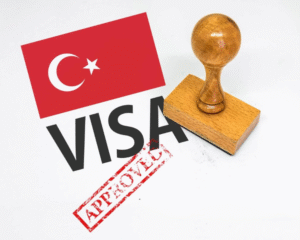Introduction
If you’ve fallen in love with Turkey during your visit – the seaside sunsets, the café culture, the relaxed pace of life — you’re not alone. Many visitors arrive on a short-term tourist visa, only to realize they’re not quite ready to leave. The good news? Transitioning from a tourist visa to a residence permit in Turkey is possible – if you handle the timing and paperwork carefully.
But let’s be honest: Turkish bureaucracy can be confusing, especially if you’re navigating it in a second language. There’s a system in place, but it’s not always clearly explained. This guide will walk you through the process step by step, with a human touch, so you know exactly what to do (and what to avoid) when making the move from tourist to temporary resident.

Understanding the Difference: Tourist Visa vs Residence Permit
Let’s start with the basics.
When you enter Turkey as a tourist, whether on a visa or visa-free entry, you’re allowed to stay between 30 and 90 days, depending on your nationality. Russian citizens, for example, get up to 60 days without a visa. This time is strictly for tourism, and once it ends, you must either leave the country or apply for a residence permit (ikamet) – a document that legally allows you to live in Turkey for a longer period (usually 1 year for the first application).
But here’s the catch: you must start your residence permit application before your tourist stay expires. If you miss the deadline, your only option is to leave Turkey, re-enter, and start the process from scratch, which is more expensive and far more stressful.
Step 1: Plan Early, Timing Is Everything
The single biggest mistake people make is waiting too long to apply. Many assume they can just “go to the office” whenever they’re ready, but that’s not how the Turkish immigration system works.
Instead, all residence applications begin online, and your submission date must fall before your visa-free days run out. Here’s what to do:
Count exactly how many days you are allowed in Turkey as a tourist. Start preparing your application at least 3–4 weeks before your tourist stay ends. You’ll need to gather documents like:
A notarized rental contract, private Turkish health insurance, biometric photos, a Turkish tax number (can be obtained online or at the tax office), and your passport and entry stamp copies. Once you’re ready, head to the official website: https://e-ikamet.goc.gov.tr
Step 2: Complete the Online Application
The e-ikamet portal is where everything begins. The site is available in English and Russian, although the translations can be awkward at times. Still, it’s manageable.
Here’s what to expect:
- You’ll fill in your personal info, passport number, entry date, address, and type of permit (most people choose short-term residence for tourism or property ownership).
- Once submitted, you’ll receive a confirmation PDF and a randevu (appointment date) at your local immigration office (Göç İdaresi).
This form is time-stamped, meaning your application is officially “in the system” from that moment. That’s what freezes the countdown on your tourist stay. As long as you submitted it before your days run out, you can legally remain in Turkey until your appointment.
Step 3: Pay the Fees and Organize Your File
You’ll need to pay two types of fees:
- Residence Card Fee – fixed for everyone (~565 TL, subject to change)
- Residence Tax – based on your nationality (usually €80–€150 for Russian citizens)
You can pay these at a local tax office or online through the Turkish banking system if you have an account. Once paid, keep all receipts; they are required at your interview.
Meanwhile, you should print and organize the rest of your documents:
- Your printed online form
- Passport + copies of ID page and entry stamp
- Four biometric photos
- Your rental contract (notarized)
- Insurance policy (valid for the entire duration)
- Proof of fee payment
- Copy of your tax number
This folder is your entire case. Missing one item can delay or even cancel your application, so double-check every detail.

Step 4: Go to Your Appointment
Your immigration interview will take place at the nearest Göç İdaresi office to your registered address. It’s usually straightforward but can involve long waits, especially in busy cities like Istanbul or Antalya.
At your appointment, you’ll meet with an officer who reviews your file, asks you to confirm your reason for staying, and checks the consistency of your paperwork.
Important tips:
- Arrive early. Some offices are crowded and operate first-come, first-served within time slots.
- Dress respectfully. It’s a formal government setting.
- Be polite and patient. Even if your Turkish is minimal, a friendly attitude goes a long way.
If everything is in order, the officer will stamp your application, and you’ll be given a temporary approval. You are now legally allowed to remain in Turkey while your residence card is processed and mailed.
Step 5: Wait for Your İkamet Card
After the interview, your residence card is printed and sent via Turkey’s national postal service (PTT) to your registered address.
This can take 2 to 8 weeks, depending on your city. In most cases, you’ll receive a tracking number by SMS, and the postman will deliver the card to your door.
During this waiting period, you’re allowed to stay in Turkey without issues. Avoid leaving the country unless you apply for a special exit-entry document in advance. If you move, notify the immigration office immediately so your card isn’t lost. Once your card arrives, you’re officially a resident of Turkey.
From Visitor to Resident, Smoothly
Making the shift from a tourist visa to a residence permit in Turkey doesn’t have to be overwhelming. But it does require a bit of planning, attention to detail, and respect for the local process.
If you’ve fallen in love with Turkey and want to stay longer, whether you’re here for peace and quiet, remote work, or a new lifestyle altogether, the ikamet is your ticket to legal living.
Turning your tourist stay into a long-term life in Turkey? Navyx’s €3,900 VIP Package covers everything from housing to legal setup. Make the switch smoothly with Navyx – we handle the hard part.
